The recent imposition of 50% US tariffs on Indian exports marks a defining moment in our nation's economic journey. While this unprecedented tariff shock initially sent ripples of concern through markets and manufacturing hubs, it has also become a catalyst for something remarkable. India's transformation into a truly self-reliant, innovation-driven economy.
The tariff announcement has fundamentally altered the trade landscape between the world's largest economy and its fastest-growing major partner. But rather than buckle under pressure, India is writing a new playbook that combines policy innovation, consumption stimulus, and technological advancement to not just weather this storm, but emerge stronger on the other side.
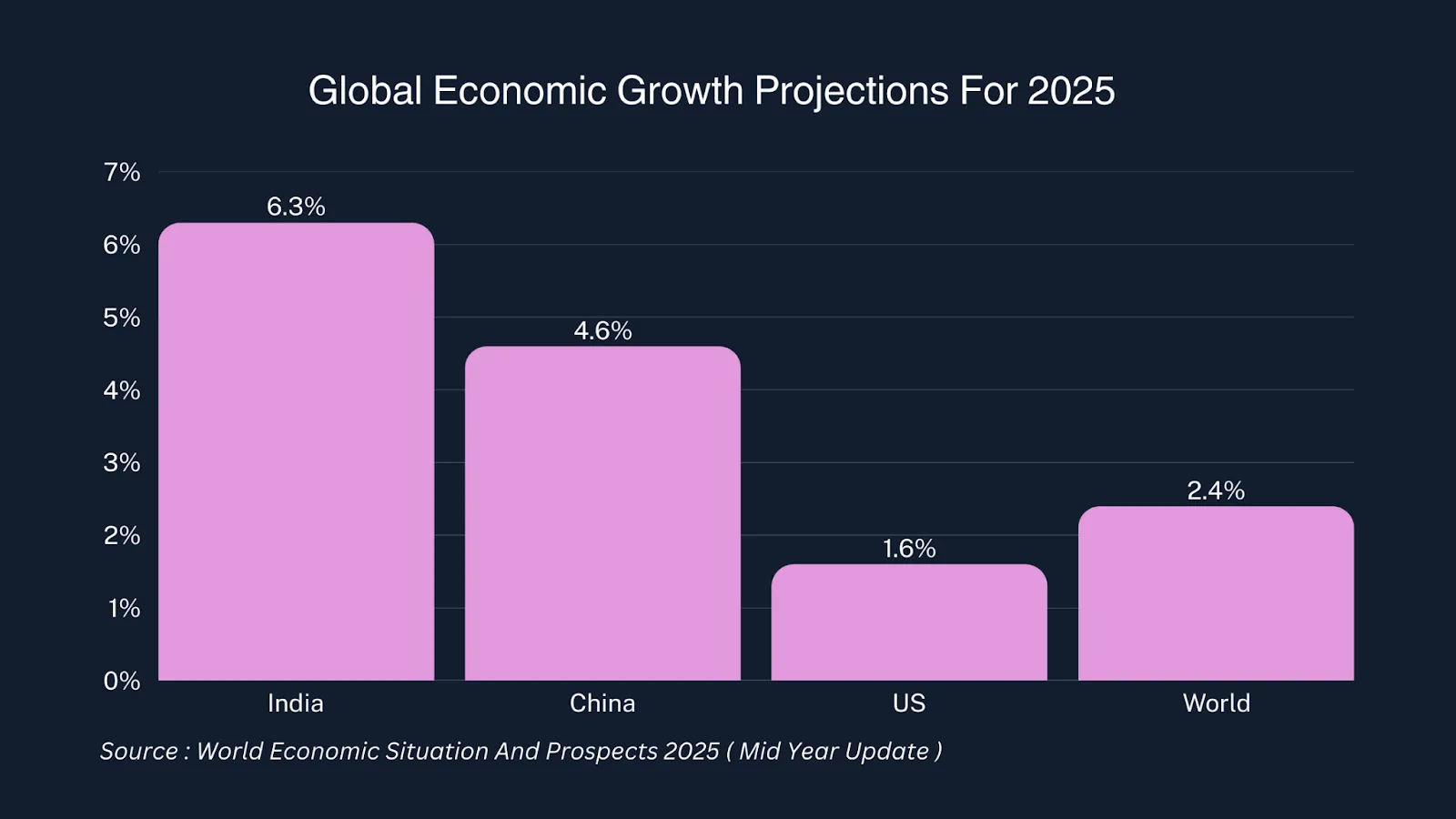
When the United States announced the doubling of tariffs on Indian goods to 50%, effective August 27, 2025, it wasn't just a trade policy change it was an economic earthquake that threatened to reshape bilateral relations between two democratic powerhouses. This punitive measure, justified by Washington as a response to India's continued energy trade with Russia, affects approximately $60.2 billion worth of Indian exports, representing 66% of all goods shipped to America.
The sectors bearing the brunt include textiles, gems and jewelry, leather goods, seafood, and auto components industries that collectively employ millions of Indians and contribute significantly to our export earnings. For context, textiles alone saw the US market account for nearly 15% of all Indian textile exports in 2024, with a total value exceeding $118 billion. Similarly, India's position as the world's largest exporter of cut and polished diamonds means that gems and jewelry exports worth over $25 billion annually face serious competitive challenges.
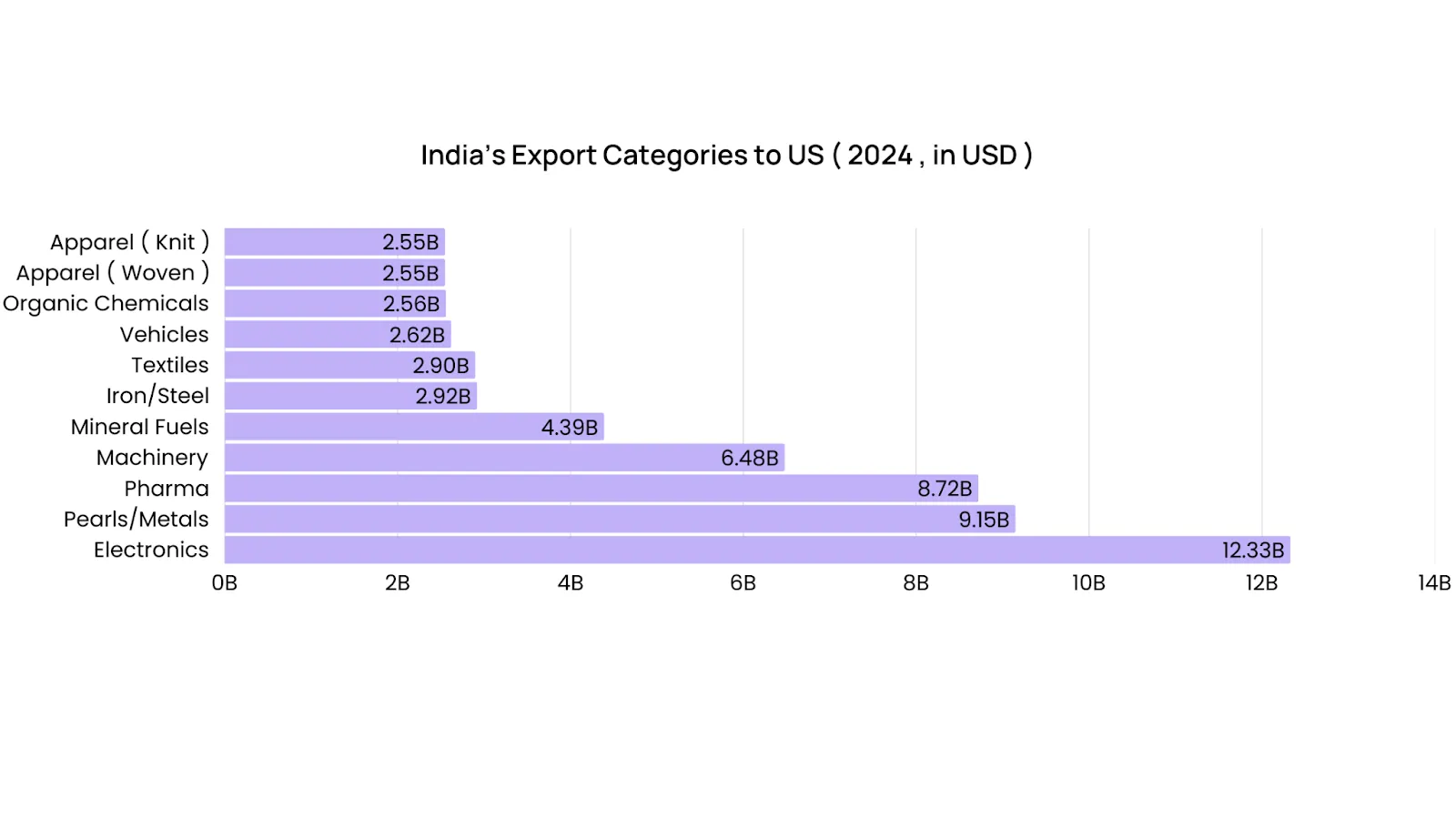
Source: Trading Economics
The immediate market reaction was telling. Indian stocks dropped sharply on the announcement day, with the Sensex falling 849 points and the Nifty declining 255 points, wiping out over ₹6 lakh crore in market capitalization. Companies like Gokaldas Exports, which derives 25-70% of revenue from US markets, faced immediate pressure as American buyers began demanding 15-20% discounts or threatened to shift production to other countries.
Despite the severity of the tariff impact, India's economic fundamentals remain remarkably robust. The country's GDP grew at 6.5% in FY 2024-25, maintaining its position as the fastest-growing major economy globally. This growth story is built on solid foundations that provide natural insulation against external shocks.
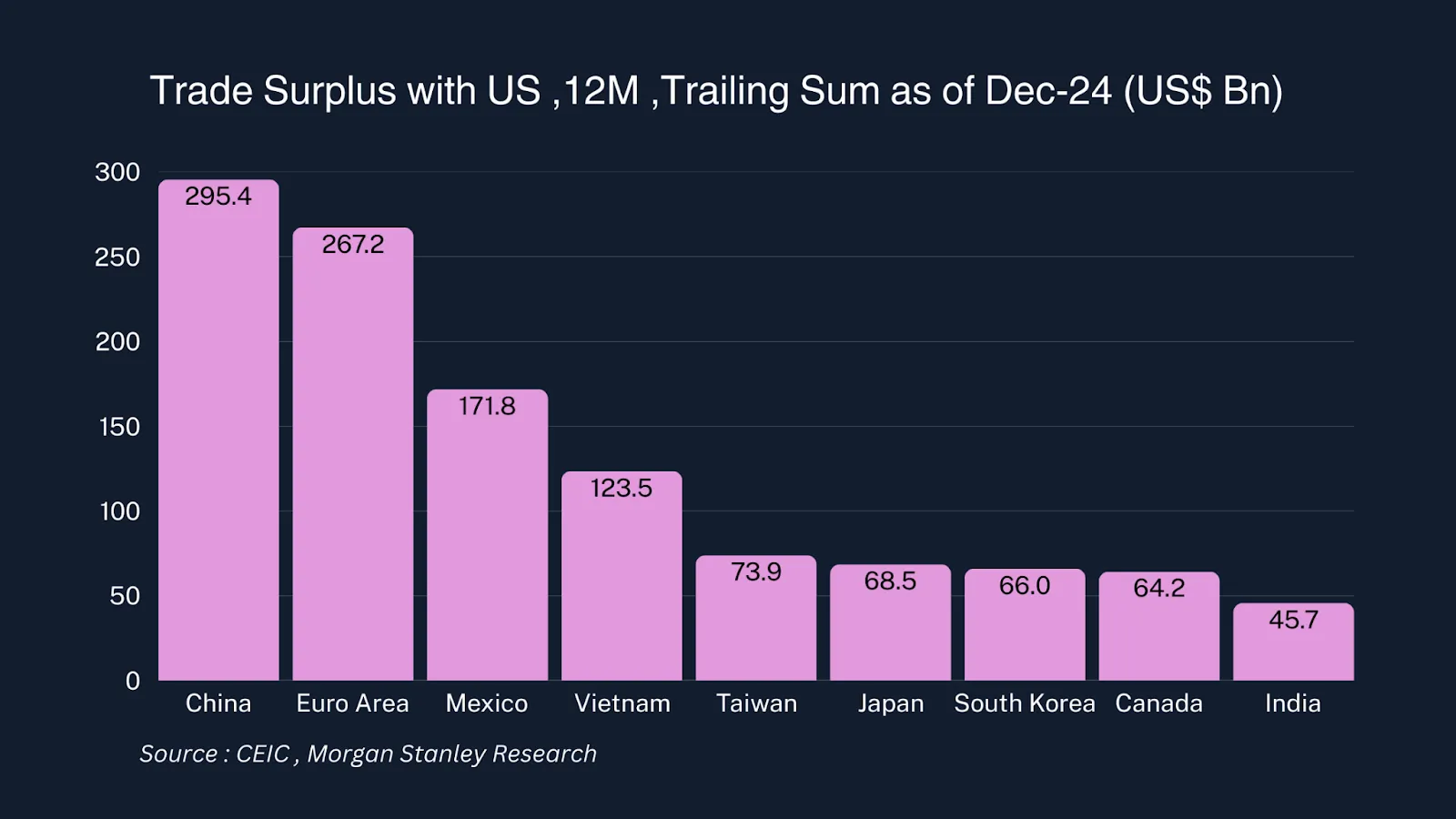
Unlike export-dependent economies, India's growth engine is powered primarily by domestic consumption, which accounts for over 61% of GDP – the highest level in two decades. This consumption-centric model means that even if export revenues decline, the domestic market continues to drive economic activity. With nearly 10 crore middle and high-income households expected to be added by 2030, India's consumer base represents one of the world's most dynamic growth stories.
The Reserve Bank of India has maintained its growth forecast at 6.5% for FY 2025-26, signaling confidence that the economy can absorb the tariff shock without derailing. Various economic projections suggest that while the tariffs may shave off 0.2-0.5 percentage points from GDP growth, the overall trajectory remains positive, with most estimates keeping growth above 6%.
India's macroeconomic stability provides the bedrock for this resilience. The country boasts strong foreign exchange reserves exceeding $690 billion, manageable debt levels, and a contained current account deficit. This financial cushion allows policymakers the flexibility to implement counter-cyclical measures without compromising fiscal discipline.
The recent upgrade of India's sovereign rating by S&P Global to 'BBB' – the first upgrade in 18 years – reflects international confidence in these fundamentals. Fitch Ratings has also maintained India's rating with a stable outlook, noting that the country's "robust growth and solid external finances" provide resilience against external pressures.
Rather than simply defending against the tariff onslaught, the Indian government has seized this moment to accelerate long-pending reforms that boost domestic consumption and economic competitiveness. The timing and scope of these measures reflect a strategic approach to convert external pressure into internal strength.
The most significant policy response has been the announcement of comprehensive GST reforms, set to be implemented by Diwali 2025. Prime Minister Modi's promise of a "massive tax bonanza" represents more than just tax cuts – it's a fundamental restructuring designed to unleash consumption power across the economy.
The proposed reforms will simplify the current four-tier GST structure (5%, 12%, 18%, 28%) into a streamlined two-tier system (5% and 18%), with a special 40% rate for sin goods. This rationalization is expected to directly benefit 11.4% of Private Final Consumption Expenditure, with SBI Research estimating a consumption boost of ₹5.31 lakh crore – equivalent to 1.6% of GDP.
The economic logic is compelling: GST rate cuts have a higher multiplier effect (1.08x) compared to direct tax reductions, potentially adding 20-50 basis points to GDP growth if benefits reach consumers. For ordinary families, this means everyday items like food products, clothing, electronics, and even insurance premiums could become significantly more affordable.
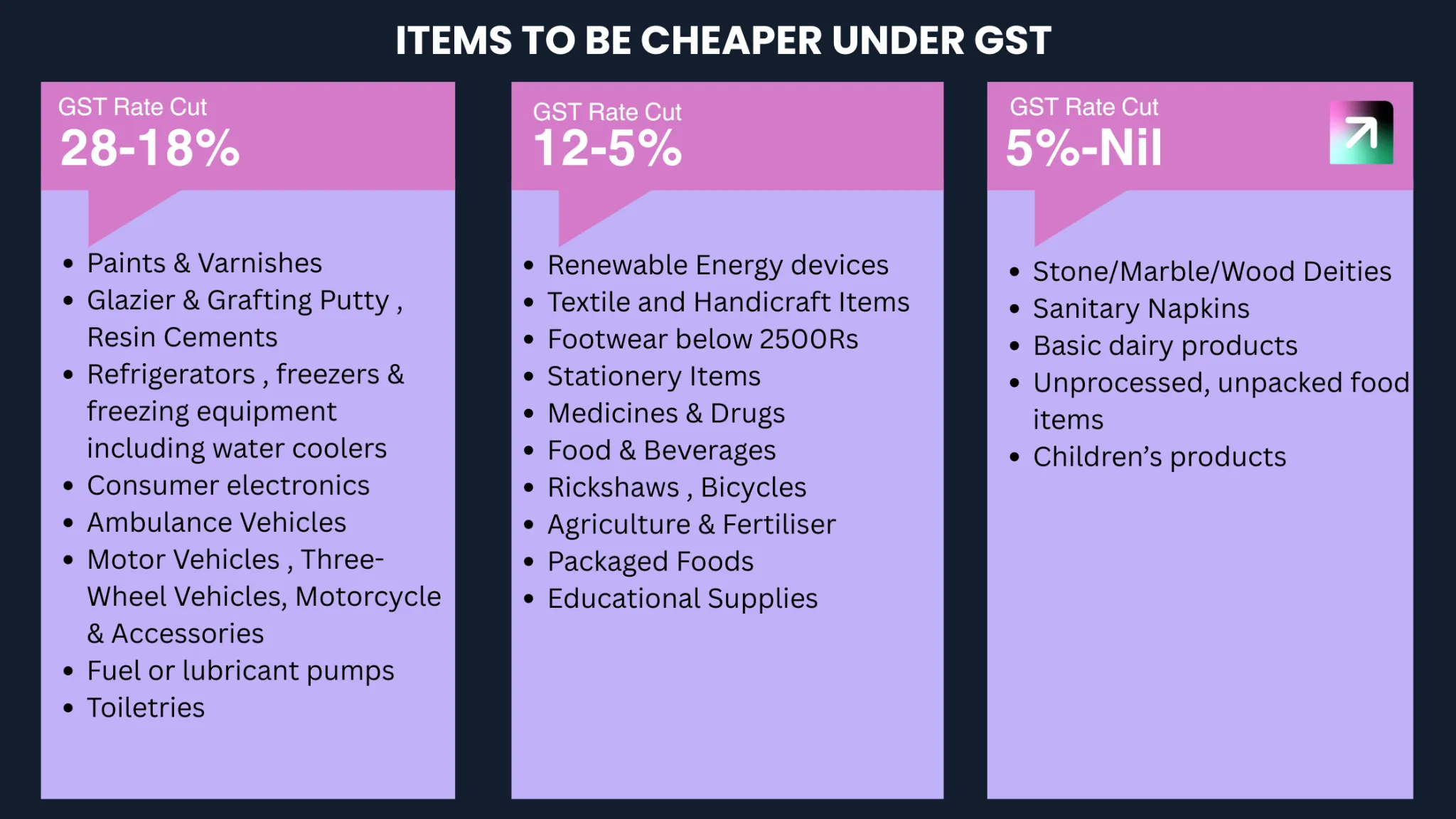
Recognizing that over-dependence on any single market creates vulnerability, India is actively pursuing Free Trade Agreements with multiple partners. The focus on textiles, leather, gems, and jewelry exports through FTAs with the UK, EFTA nations, and others represents a systematic effort to reduce reliance on the US market. These agreements aim to provide Indian exporters with alternative destinations that offer more favorable terms.
The tariff challenge has accelerated India's transition toward a knowledge and innovation-based economy. The vision of 'New India' is not just about manufacturing goods more efficiently, but about creating entirely new categories of value through technology, innovation, and entrepreneurship.
India's digital economy presents perhaps the most compelling growth story of our times. Currently valued at 11.74% of GDP in 2022-23 (approximately ₹31.64 lakh crore), the digital sector is projected to grow almost twice as fast as the overall economy, reaching nearly 20% of national income by 2030.
This transformation is remarkable in its scope and speed. The digital-enabling industries, including ICT services, telecommunications, and electronics manufacturing, currently contribute 7.83% to GDP. Meanwhile, new digital industries comprising Big Tech players, platforms, and digital intermediaries account for nearly 2% of GDP , a figure that rivals the contribution of traditional sectors that have been digitized.
The employment impact is equally significant. The digital economy currently employs 14.67 million workers, representing 2.55% of India's workforce. However, this sector is five times more productive than traditional sectors, indicating the premium value creation potential of digital transformation.
The government's innovation framework extends far beyond digitization. Initiatives like Startup India, Atal Innovation Mission, and the Production Linked Incentive (PLI) schemes are creating an ecosystem where innovation thrives. The PLI schemes alone have attracted investments worth ₹1.75 lakh crore across 14 strategic sectors, creating over 1.2 million direct and indirect jobs.
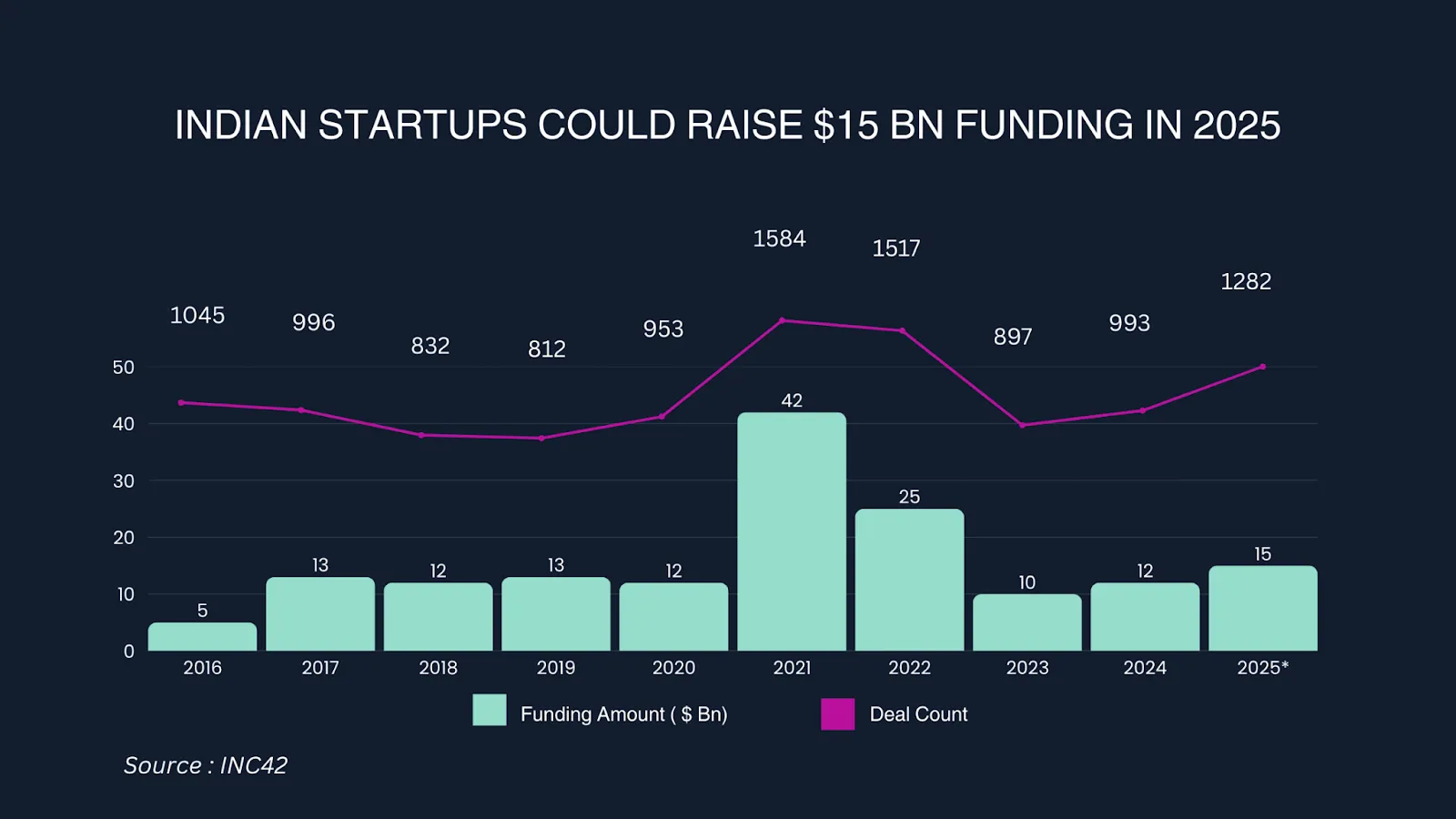
India's startup ecosystem has evolved into the world's third-largest, with over 12,000 startups and multiple unicorn companies. The government's target of increasing R&D spending to 2% of GDP from the current 0.7% signals the priority placed on innovation-driven growth. This investment in innovation creates the high-value jobs and industries that are naturally insulated from traditional trade pressures.
The concept of Atmanirbhar Bharat (Self-Reliant India) has evolved from a policy slogan to a practical economic strategy that balances self-sufficiency with global competitiveness. The tariff shock has provided the urgency needed to accelerate this transformation.
The Make in India initiative, combined with PLI schemes, is creating a new manufacturing landscape. FDI in the manufacturing sector has grown by 69% over the past decade, rising from ₹8.37 lakh crore during 2004-14 to ₹14.14 lakh crore during 2014-24. This growth reflects India's emergence as a viable alternative to other manufacturing hubs.
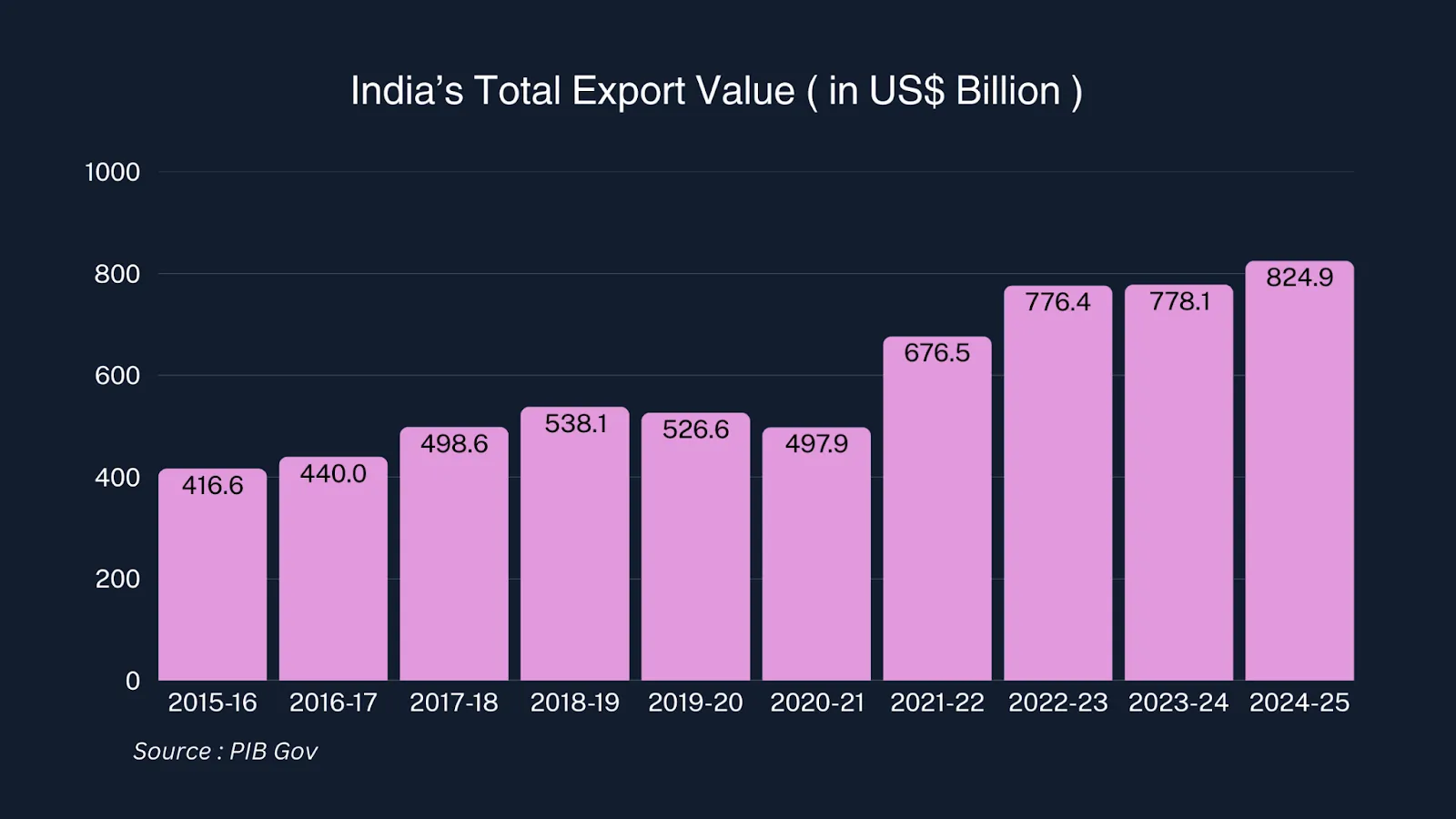
The focus on high-value manufacturing is particularly important. Sectors like electronics, pharmaceuticals, automobiles, and textiles are not just producing for domestic consumption but building global supply chain capabilities. The electronics sector alone has seen 39.51% growth in exports from April 2024 to April 2025.
Prime Minister Modi's call for businesses to "exclusively purchase and promote Made in India products" is not about protectionism but about building resilient supply chains that can serve both domestic and international markets. The emphasis on quality standards ensures that Indian products can compete globally while reducing import dependence.
The five pillars of Atmanirbhar Bharat i.e Economy, Infrastructure, System, Vibrant Demography, and Demand – provide a comprehensive framework for this transformation. Each pillar reinforces the others, creating a virtuous cycle of growth, innovation, and self-reliance.
The focus on boosting domestic consumption represents a fundamental shift in economic strategy. Rather than relying primarily on export-led growth, India is leveraging its vast domestic market as the primary growth driver.
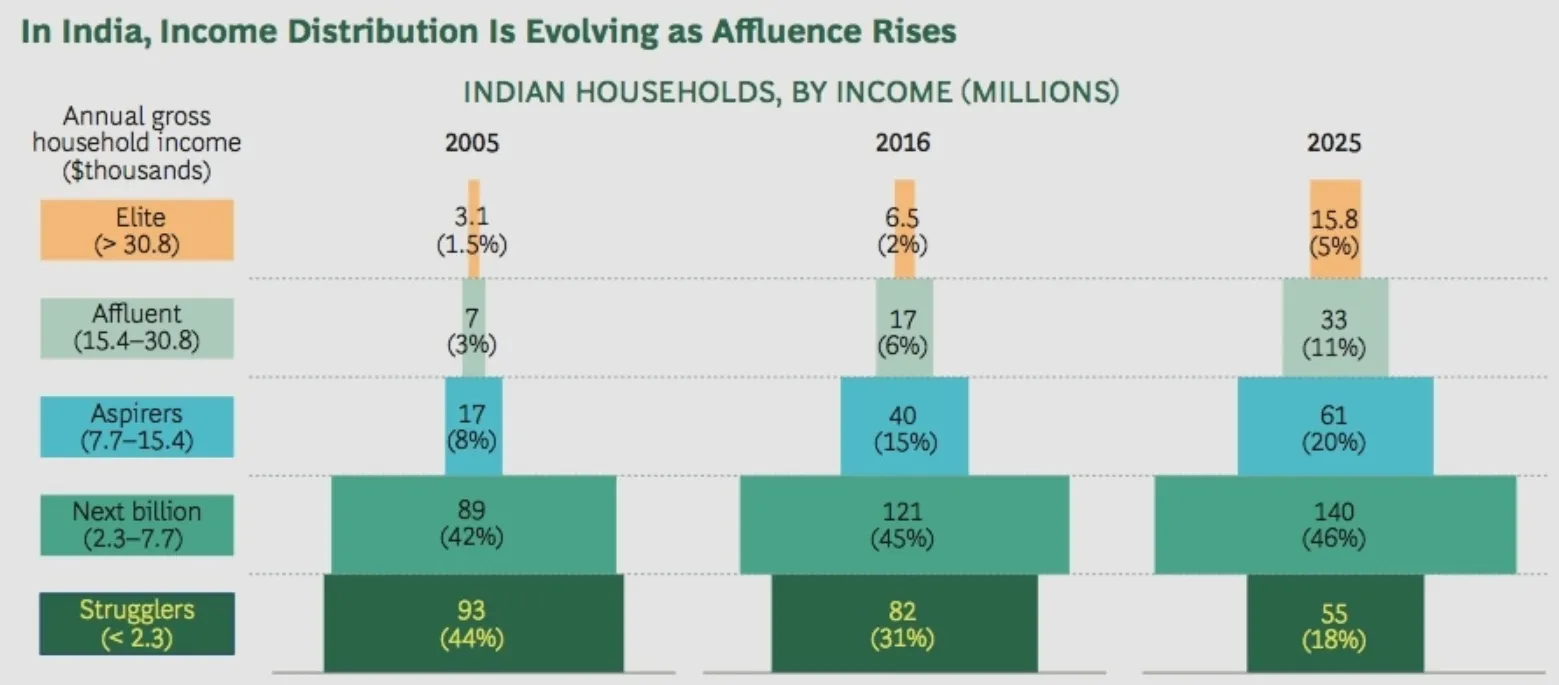
Source: Consultancy.IN
With nearly 10 crore new middle and high-income households expected by 2030, India's consumer market is poised for unprecedented expansion. This demographic dividend, combined with rising disposable incomes and changing consumption patterns, creates a natural buffer against export volatility.
The proposed GST reforms will particularly benefit this expanding middle class. Items ranging from household goods to electronics to insurance will become more affordable, creating additional purchasing power that flows through the entire economy. The multiplier effect of increased consumption touches every sector, from agriculture to services to manufacturing.
The emphasis on digital infrastructure and financial inclusion has brought rural markets into the formal economy. Digital payment systems like UPI have revolutionized how rural consumers access goods and services, creating new consumption opportunities. The government's focus on rural infrastructure, from roads to broadband, ensures that economic growth is geographically inclusive.
The consumption boost is not just about buying more goods – it's about improving quality of life. Better healthcare access through digital platforms, educational opportunities through online learning, and financial services through fintech innovations all contribute to human development while driving economic growth.
India's response to the tariff challenge demonstrates sophisticated economic diplomacy. Rather than engaging in a tit-for-tat trade war, the country is pursuing a multi-pronged strategy that strengthens its global position while building domestic resilience.
The active pursuit of FTAs with the UK, EU, Australia, and other partners represents a systematic effort to reduce dependence on any single market. These agreements provide Indian exporters with alternative destinations while creating new opportunities for technology transfer and investment collaboration.
The focus on high-value exports in sectors like pharmaceuticals, IT services, and renewable energy technologies positions India as a provider of sophisticated goods and services rather than just low-cost manufacturing. This shift toward knowledge-intensive exports naturally commands higher margins and is less susceptible to cost-based competition.
Despite the trade tensions, India continues to attract significant foreign investment. FDI inflows reached $81.04 billion in FY 2024-25, marking a 14% increase from the previous year. The services sector attracted 19% of total FDI inflows, followed by computer software and hardware at 16%, indicating strong investor confidence in India's high-value sectors.

The government's investor-friendly policies, including 100% FDI in most sectors through the automatic route, demonstrate commitment to maintaining an open economy while building domestic capabilities. This balance between openness and self-reliance is crucial for long-term economic success.
The transition toward an innovation-driven economy is creating entirely new categories of employment and value creation. These developments are particularly important for India's young population, which needs modern, high-skilled job opportunities.
India's IT sector continues to expand globally, with companies like TCS ($29 billion revenue), Infosys ($19 billion), and Wipro ($11 billion) leading the charge. These companies are not just service providers but innovation partners for global corporations, creating high-value jobs in research, development, and consulting.
The expansion into emerging technologies like artificial intelligence, blockchain, and quantum computing positions India at the forefront of the next technological revolution. With over 650 million smartphone users and 950 million internet subscribers, India has the digital infrastructure to support advanced technology adoption.
The startup ecosystem has become a significant employer and innovator. With India hosting about 55% of the world's Global Capability Centers and maintaining the third-largest startup ecosystem globally, entrepreneurship is becoming a mainstream career path.
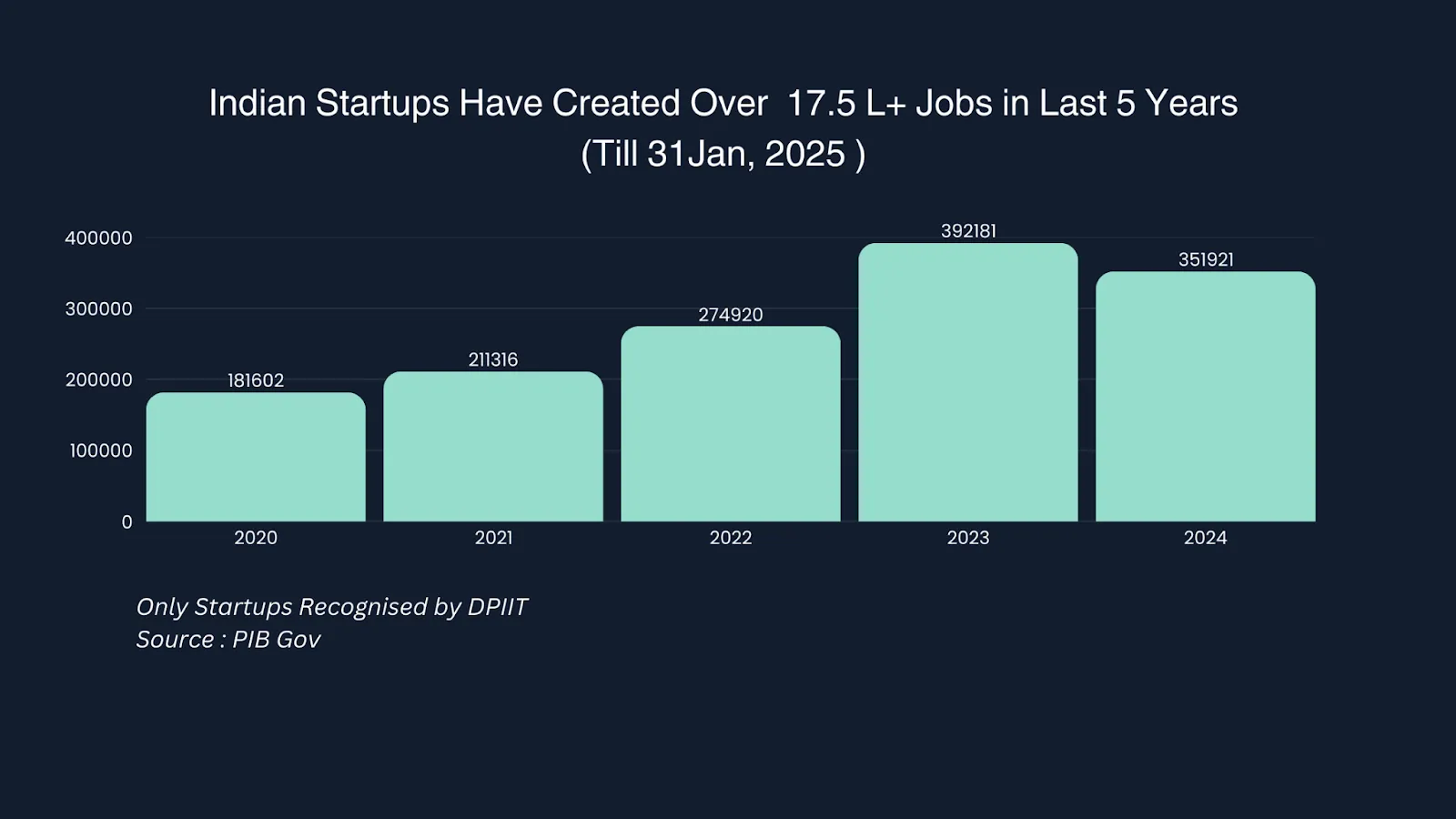
Government initiatives like the Startup India campaign have supported over 41,000 startups since 2016, creating a culture of innovation and risk-taking. This entrepreneurial energy is crucial for developing solutions to uniquely Indian challenges while creating globally competitive products and services.
The 50% US tariff shock, while initially disruptive, has catalyzed a comprehensive transformation of the Indian economy. Rather than simply responding defensively, India has used this challenge as an opportunity to accelerate reforms, boost domestic consumption, and build innovation capabilities that will serve the country well into the future.
The combination of GST reforms boosting consumption, innovation investments creating high-value jobs, and manufacturing initiatives building industrial capabilities represents a holistic approach to economic development. The digital economy's projected growth to 20% of GDP by 2030, supported by strong FDI inflows and entrepreneurial energy, positions India at the forefront of the global knowledge economy.
Most importantly, this transformation is happening through democratic consensus and inclusive policies that ensure benefits reach all sections of society. The emphasis on Atmanirbhar Bharat is not about economic isolationism but about building the confidence and capabilities needed to engage with the world from a position of strength.
As we look toward the future, the current tariff challenge will likely be remembered not as a crisis that weakened India, but as the catalyst that accelerated its emergence as a truly modern, innovation-driven, and self-reliant economy. The New India that emerges from this transformation will be more resilient, more innovative, and more prosperous than ever before.
Discover investment portfolios that are designed for maximum returns at low risk.
Learn how we choose the right asset mix for your risk profile across all market conditions.
Get weekly market insights and facts right in your inbox
It depicts the actual and verifiable returns generated by the portfolios of SEBI registered entities. Live performance does not include any backtested data or claim and does not guarantee future returns.
By proceeding, you understand that investments are subjected to market risks and agree that returns shown on the platform were not used as an advertisement or promotion to influence your investment decisions.
"I was drawn to Wright Research due to its multi-factor approach. Their Balanced MFT is an excellent product."

By Prashant Sharma
CTO, Zydus
By signing up, you agree to our Terms and Privacy Policy
"I was drawn to Wright Research due to its multi-factor approach. Their Balanced MFT is an excellent product."

By Prashant Sharma
CTO, Zydus
Skip Password
By signing up, you agree to our Terms and Privacy Policy
"I was drawn to Wright Research due to its multi-factor approach. Their Balanced MFT is an excellent product."

By Prashant Sharma
CTO, Zydus
"I was drawn to Wright Research due to its multi-factor approach. Their Balanced MFT is an excellent product."

By Prashant Sharma
CTO, Zydus
Log in with Password →
By logging in, you agree to our Terms and Privacy Policy
"I was drawn to Wright Research due to its multi-factor approach. Their Balanced MFT is an excellent product."

By Prashant Sharma
CTO, Zydus
Log in with OTP →
By logging in, you agree to our Terms and Privacy Policy
"I was drawn to Wright Research due to its multi-factor approach. Their Balanced MFT is an excellent product."

By Prashant Sharma
CTO, Zydus
Answer these questions to get a personalized portfolio or skip to see trending portfolios.
Answer these questions to get a personalized portfolio or skip to see trending portfolios.
(You can choose multiple options)
Answer these questions to get a personalized portfolio or skip to see trending portfolios.
Answer these questions to get a personalized portfolio or skip to see trending portfolios.
Answer these questions to get a personalized portfolio or skip to see trending portfolios.
(You can choose multiple options)
Investor Profile Score
We've tailored Portfolio Management services for your profile.
View Recommended Portfolios Restart